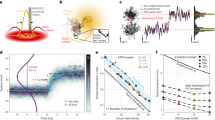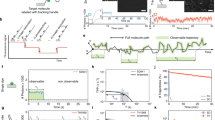Abstract
The ability of proteins to locate specific target sequences or structures among a vast excess of nonspecific DNA is a fundamental property that affects virtually all aspects of biology. Despite this importance, experimental methods have lagged behind the establishment of theoretical principles describing potential target location mechanisms. However, recent advances in single-molecule detection now allow direct visual observation of proteins diffusing along DNA. Here we present an overview of these new observations and discuss the advantages, limitations and future prospects for imaging the motion of proteins along DNA.
This is a preview of subscription content, access via your institution
Access options
Subscribe to this journal
Receive 12 print issues and online access
$189.00 per year
only $15.75 per issue
Buy this article
- Purchase on Springer Link
- Instant access to full article PDF
Prices may be subject to local taxes which are calculated during checkout



Similar content being viewed by others
References
Adam, G. & Delbrück, M. Reduction of dimensionality in biological diffusion processes. in Structural Chemistry and Molecular Biology (eds. Rich, A. & Davidson, N.) 198–215 (W.H. Freeman and Company, San Francisco; London, 1968).
Riggs, A.D., Bourgeois, S. & Cohn, M. The lac repressor-operator interaction. 3. Kinetic studies. J. Mol. Biol. 53, 401–417 (1970).
Berg, O.G. & Ehrenberg, M. Association kinetics with coupled three- and one-dimensional diffusion. Chain-length dependence of the association rate of specific DNA sites. Biophys. Chem. 15, 41–51 (1982).
Berg, O.G., Winter, R.B. & von Hippel, P.H. Diffusion-driven mechanisms of protein translocation on nucleic acids. 1. Models and theory. Biochemistry 20, 6929–6948 (1981).
Winter, R.B., Berg, O.G. & von Hippel, P.H. Diffusion-driven mechanisms of protein translocation on nucleic acids. 3. The Escherichia coli lac repressor–operator interaction: kinetic measurements and conclusions. Biochemistry 20, 6961–6977 (1981).
von Hippel, P.H. & Berg, O.G. Facilitated target location in biological systems. J. Biol. Chem. 264, 675–678 (1989).
Jack, W.E., Terry, B.J. & Modrich, P. Involvement of outside DNA sequences in the major kinetic path by which EcoRI endonuclease locates and leaves its recognition sequence. Proc. Natl. Acad. Sci. USA 79, 4010–4014 (1982).
Gowers, D.M., Wilson, G.G. & Halford, S.E. Measurement of the contributions of 1D and 3D pathways to the translocation of a protein along DNA. Proc. Natl. Acad. Sci. USA 102, 15883–15888 (2005).
Dowd, D.R. & Lloyd, R.S. Biological significance of facilitated diffusion in protein-DNA interactions. Applications to T4 endonuclease V-initiated DNA repair. J. Biol. Chem. 265, 3424–3431 (1990).
Jeltsch, A., Alves, J., Wolfes, H., Maass, G. & Pingoud, A. Pausing of the restriction endonuclease EcoRI during linear diffusion on DNA. Biochemistry 33, 10215–10219 (1994).
Jeltsch, A. & Pingoud, A. Kinetic characterization of linear diffusion of the restriction endonuclease EcoRV on DNA. Biochemistry 37, 2160–2169 (1998).
Jeltsch, A., Wenz, C., Stahl, F. & Pingoud, A. Linear diffusion of the restriction endonuclease EcoRV on DNA is essential for the in vivo function of the enzyme. EMBO J. 15, 5104–5111 (1996).
McKinney, K., Mattia, M., Gottifredi, V. & Prives, C. p53 linear diffusion along DNA requires its C terminus. Mol. Cell 16, 413–424 (2004).
Randell, J.C. & Coen, D.M. Linear diffusion on DNA despite high-affinity binding by a DNA polymerase processivity factor. Mol. Cell 8, 911–920 (2001).
Mazur, D.J., Mendillo, M.L. & Kolodner, R.D. Inhibition of Msh6 ATPase activity by mispaired DNA induces a Msh2(ATP)-Msh6(ATP) state capable of hydrolysis-independent movement along DNA. Mol. Cell 22, 39–49 (2006).
Mendillo, M.L., Mazur, D.J. & Kolodner, R.D. Analysis of the interaction between the Saccharomyces cerevisiae MSH2–MSH6 and MLH1–PMS1 complexes with DNA using a reversible DNA end-blocking system. J. Biol. Chem. 280, 22245–22257 (2005).
Gradia, S. et al. hMSH2-hMSH6 forms a hydrolysis-independent sliding clamp on mismatched DNA. Mol. Cell 3, 255–261 (1999).
Snowden, T., Acharya, S., Butz, C., Berardini, M. & Fishel, R. hMSH4-hMSH5 recognizes Holliday junctions and forms a meiosis-specific sliding clamp that embraces homologous chromosomes. Mol. Cell 15, 437–451 (2004).
Acharya, S., Foster, P.L., Brooks, P. & Fishel, R. The coordinated functions of the E. coli MutS and MutL proteins in mismatch repair. Mol. Cell 12, 233–246 (2003).
Iwahara, J., Zweckstetter, M. & Clore, G.M. NMR structural and kinetic characterization of a homeodomain diffusing and hopping on nonspecific DNA. Proc. Natl. Acad. Sci. USA 103, 15062–15067 (2006).
Iwahara, J. & Clore, G.M. Detecting transient intermediates in macromolecular binding by paramagnetic NMR. Nature 440, 1227–1230 (2006).
Schurr, J.M. The one-dimensional diffusion coefficient of proteins absorbed on DNA. Hydrodynamic considerations. Biophys. Chem. 9, 413–414 (1975).
Bagchi, B., Blainey, P.C. & Xie, X.S. Diffusion constant of a nonspecifically bound protein undergoing curvilinear motion along DNA. J. Phys. Chem. B 112, 6282–6284 (2008).
Halford, S.E. & Marko, J.F. How do site-specific DNA-binding proteins find their targets? Nucleic Acids Res. 32, 3040–3052 (2004).
Kampmann, M. Facilitated diffusion in chromatin lattices: mechanistic diversity and regulatory potential. Mol. Microbiol. 57, 889–899 (2005).
Halford, S.E. & Szczelkun, M.D. How to get from A to B: strategies for analysing protein motion on DNA. Eur. Biophys. J. 31, 257–267 (2002).
Slutsky, M. & Mirny, L.A. Kinetics of protein-DNA interaction: facilitated target location in sequence-dependent potential. Biophys. J. 87, 4021–4035 (2004).
Kalodimos, C.G. et al. Structure and flexibility adaptation in nonspecific and specific protein-DNA complexes. Science 305, 386–389 (2004).
Pingoud, A. & Wende, W. A sliding restriction enzyme pauses. Structure 15, 391–393 (2007).
Erie, D.A., Yang, G., Schultz, H.C. & Bustamante, C. DNA bending by Cro protein in specific and nonspecific complexes: implications for protein site recognition and specificity. Science 266, 1562–1566 (1994).
Singer, P. & Wu, C.W. Promoter search by Escherichia coli RNA polymerase on a circular DNA template. J. Biol. Chem. 262, 14178–14189 (1987).
Bustamante, C., Guthold, M., Zhu, X. & Yang, G. Facilitated target location on DNA by individual Escherichia coli RNA polymerase molecules observed with the scanning force microscope operating in liquid. J. Biol. Chem. 274, 16665–16668 (1999).
Harada, Y. et al. Single-molecule imaging of RNA polymerase-DNA interactions in real time. Biophys. J. 76, 709–715 (1999).
Kabata, H. et al. Visualization of single molecules of RNA polymerase sliding along DNA. Science 262, 1561–1563 (1993).
Kim, J.H. & Larson, R.G. Single-molecule analysis of 1D diffusion and transcription elongation of T7 RNA polymerase along individual stretched DNA molecules. Nucleic Acids Res. 35, 3848–3858 (2007).
Wang, Y.M., Austin, R.H. & Cox, E.C. Single molecule measurements of repressor protein 1D diffusion on DNA. Phys. Rev. Lett. 97, 048302 (2006).
Graneli, A., Yeykal, C.C., Robertson, R.B. & Greene, E.C. Long-distance lateral diffusion of human Rad51 on double-stranded DNA. Proc. Natl. Acad. Sci. USA 103, 1221–1226 (2006).
Blainey, P.C., van Oijen, A.M., Banerjee, A., Verdine, G.L. & Xie, X.S. A base-excision DNA-repair protein finds intrahelical lesion bases by fast sliding in contact with DNA. Proc. Natl. Acad. Sci. USA 103, 5752–5757 (2006).
Jiricny, J. The multifaceted mismatch-repair system. Nat. Rev. Mol. Cell Biol. 7, 335–346 (2006).
Kunkel, T.A. & Erie, D.A. DNA mismatch repair. Annu. Rev. Biochem. 74, 681–710 (2005).
Pluciennik, A. & Modrich, P. Protein roadblocks and helix discontinuities are barriers to the initiation of mismatch repair. Proc. Natl. Acad. Sci. USA 104, 12709–12713 (2007).
Obmolova, G., Ban, C., Hsieh, P. & Yang, W. Crystal structures of mismatch repair proetin MutS and its complex with a substrate DNA. Nature 407, 703–710 (2000).
Lamers, M.H. et al. The crystal structure of DNA mismatch repair protein MutS binding to a G × T mismatch. Nature 407, 711–717 (2000).
Warren, J.J. et al. Structure of the human MutSα DNA lesion recognition complex. Mol. Cell 26, 579–592 (2007).
Gorman, J. et al. Dynamic basis for one-dimensional DNA scanning by the mismatch repair complex Msh2-Msh6. Mol. Cell 28, 359–370 (2007).
Sakata-Sogawa, K. & Shimamoto, N. RNA polymerase can track a DNA groove during promoter search. Proc. Natl. Acad. Sci. USA 101, 14731–14735 (2004).
Gorski, S.A., Dundr, M. & Misteli, T. The road much traveled: trafficking in the cell nucleus. Curr. Opin. Cell Biol. 18, 284–290 (2006).
Stanford, N.P., Szczelkun, M.D., Marko, J.F. & Halford, S.E. One- and three-dimensional pathways for proteins to reach specific DNA sites. EMBO J. 19, 6546–6557 (2000).
Misteli, T. Protein dynamics: implications for nuclear architecture and gene expression. Science 291, 843–847 (2001).
Phair, R.D. et al. Global nature of dynamic protein-chromatin interactions in vivo: three-dimensional genome scanning and dynamic interaction networks of chromatin proteins. Mol. Cell. Biol. 24, 6393–6402 (2004).
Gerland, U., Moroz, J.D. & Hwa, T. Physical constraints and functional characteristics of transcription factor-DNA interaction. Proc. Natl. Acad. Sci. USA 99, 12015–12020 (2002).
Mueller, F., Wach, P. & McNally, J.G. Evidence for a common mode of transcription factor interaction with chromatin as revealed by improved quantitative FRAP. Biophys. J. 94, 3323–3339 (2008).
Elf, J., Li, G.-W. & Xie, X.S. Probing transcription factor dynamics at the single-molecule level in a living cell. Science 316, 1191–1194 (2007).
Spies, M., Amitani, I., Baskin, R.J. & Kowalczykowski, S.C. RecBCD enzyme switches lead motor subunits in response to χ recognition. Cell 131, 694–705 (2007).
Pease, P.J. et al. Sequence-directed DNA translocation by purified FtsK. Science 307, 586–590 (2005).
Seidel, R. et al. Real-time observation of DNA translocation by the type I restriction modification enzyme EcoR124I. Nat. Struct. Mol. Biol. 11, 838–843 (2004).
Cairns, B.R. Chromatin remodeling: insights and intrigue from single-molecule studies. Nat. Struct. Mol. Biol. 14, 989–996 (2007).
Schluesche, P., Stelzer, G., Piaia, E., Lamb, D.C. & Meisterernst, M. NC2 mobilizes TBP on core promoter TATA boxes. Nat. Struct. Mol. Biol. 14, 1196–1201 (2007).
Lengronne, A. et al. Cohesin relocation from sites of chromosomal loading to places of convergent transcription. Nature 430, 573–578 (2004).
Ranjith, P., Yan, J. & Marko, J.F. Nucleosome hopping and sliding kinetics determined from dynamics of single chromatin fibers in Xenopus egg extracts. Proc. Natl. Acad. Sci. USA 104, 13649–13654 (2007).
Bonnet, I. et al. Sliding and jumping of single EcoRV restriction enzymes on non-cognate DNA. Nucleic Acids Res. 36, 4118–4127 (2008).
Tafvizi, A. et al. Tumor suppressor p53 slides on DNA with low friction and high stability. Biophys. J. 95, L01–L03 (2008).
Acknowledgements
We apologize to the researchers whose contributions could not be acknowledged because of space constraints. We also thank members of the Greene laboratory for critically reading the manuscript and providing insightful comments. E.C.G. is supported by funds from the US National Institutes of Health (NIH; GM074739) and a PECASE Award from the US National Science Foundation (0544638). J.G. is supported by an NIH training grant for Cellular and Molecular Foundations of Biomedical Sciences (T32GM00879807). We thank the referees for several insightful suggestions that have been incorporated into the final version of the Review.
Author information
Authors and Affiliations
Corresponding author
Rights and permissions
About this article
Cite this article
Gorman, J., Greene, E. Visualizing one-dimensional diffusion of proteins along DNA. Nat Struct Mol Biol 15, 768–774 (2008). https://doi.org/10.1038/nsmb.1441
Received:
Accepted:
Published:
Issue Date:
DOI: https://doi.org/10.1038/nsmb.1441
This article is cited by
-
Unconventionally fast transport through sliding dynamics of rodlike particles in macromolecular networks
Nature Communications (2024)
-
A mini-review of the diffusion dynamics of DNA-binding proteins: experiments and models
Journal of the Korean Physical Society (2021)
-
Inferring quantity and qualities of superimposed reaction rates from single molecule survival time distributions
Scientific Reports (2020)
-
Eukaryotic transcription factors can track and control their target genes using DNA antennas
Nature Communications (2020)
-
Accuracy of the detection of binding events using 3D single particle tracking
BMC Biophysics (2017)



